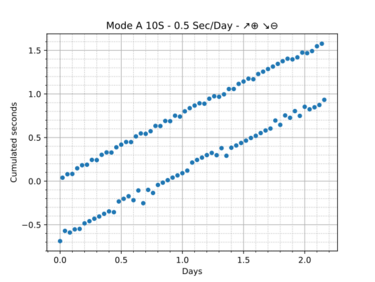Seiko converter is a software allowing to generate graphs based on the raw data produced by the Seiko Qt-2100 Timegrapher device.
By using an interface like the Libre Printer one, which can replace a parallel or serial printer, you can obtain data as sent by older devices whose printers have unfortunately broken down.
Sometimes old devices cannot be replaced for cost reasons or simply because there is no justification to do so. However, they often work in pairs with printers that are no longer manufactured and are often the weak point of the installation because they are prone to breakdowns and the abandonment of the manufacture of their consumables.
The printer linked to the Seiko Qt-2100 chronograph is one of those rare instruments whose specifications have either never been published or have long been lost.
The specific aim of this project is to process the print data from this device, making it readable, usable and printable again according to current modern standards.
In order from left to right, Print Mode A 10S graphs in 3 eras: the 70's, actual concurrent project, this project
This program automatically supports print modes A and B on the QT-2100. Have a look at the page in the original manual that introduces them : image.
The mode C is covered by the CSV output (also available on all the other modes).
As shown in the image above, dots resulting from measurement error on the device's side are corrected using the most neutral value possible (the average of the tick or tock values) and clearly displayed on the figure (red dot).
Horizontal layout is closer to the rendering of modern timegraphers, but the readability of an ever-expanding downward graph can be easier.
$ python -m seiko_converter -i data/seiko_qt2100_A10S.raw -g --horizontal
Data can be added indefinitely to such a graph. Controlling value overflow for long data series is important. A cutoff value can be chosen automatically on the basis of the data or specified by the user.
$ python -m seiko_converter -i data/seiko_qt2100_A10S.raw -g --vertical -c
$ python -m seiko_converter -i data/seiko_qt2100_A10S.raw -g --vertical -c 10
For further analysis.
$ python -m seiko_converter -h
usage: __main__.py [-h] -i INPUT_FILE [-o [OUTPUT_FILENAME]] [--csv] [-g] [--horizontal] [--vertical] [-c [CUTOFF]] [-d] [--version] [-v]
options:
-h, --help show this help message and exit
-i INPUT_FILE, --input_file INPUT_FILE
Raw file from device. (default: None)
-o [OUTPUT_FILENAME], --output_filename [OUTPUT_FILENAME]
Generated file name. (default: None)
--csv Extract the parsed values into a CSV file. (default: False)
-g, --graph Extract the parsed values into a timegrapher style file. (default: False)
-d, --debug Show the matplotlib windows. (default: False)
--version show program's version number and exit
-v, --verbose
Graph options:
--horizontal Make a horizontal graph that expand downwards; default is vertical.
--vertical Make a vertical graph that expand downwards (default).
-c [CUTOFF], --cutoff [CUTOFF]
Only for Mode A graphs. Allow wrapped display to limit infinite graph expansion on the right
direction (x-axis). If set on vertical graph: rate values will be cut; if set on horizontal graph:
days will be cut. Set it to True for auto-cut (2 days in horizontal mode), False for disabling the
feature, or with a custom value adapted to the chosen mode (limit value or time limit in days).
(default: True)
Seiko converter is released under the AGPL (Affero General Public License).








